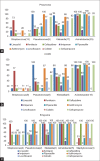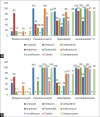Antibiotic Prescription, Organisms and its Resistance Pattern in Patients Admitted to Respiratory ICU with Respiratory Infection in Mysuru
- PMID: 29743760
- PMCID: PMC5930525
- DOI: 10.4103/ijccm.IJCCM_409_17
Antibiotic Prescription, Organisms and its Resistance Pattern in Patients Admitted to Respiratory ICU with Respiratory Infection in Mysuru
Abstract
Aim of study: Respiratory infections account for significant morbidity, mortality and expenses to patients getting admitted to ICU. Antibiotic resistance is a major worldwide concern in ICU, including India. It is important to know the antibiotic prescribing pattern in ICU, organisms and its resistance pattern as there is sparse data on Indian ICUs.
Materials and methods: We conducted a prospective study from August 2015 to February 2016. All patients getting admitted to RICU with respiratory infection who were treated with antibiotics were included into study. Demographic details, comorbidities, Clinco-pathological score (CPI) on day1 and 2 of admission, duration of ICU admission, number of antibiotics used, antibiotic prescription, antimicrobial resistance pattern of patients were collected using APRISE questionnaire.
Results: During study period 352 patients were screened and 303 patients were included into study. Mean age was 56.05±16.37 and 190 (62.70%) were men. Most common diagnosis was Pneumonia (66%). Piperacillin-tazobactam was most common empirical antibiotic used. We found 60% resistance to piperacillin-tazobactam. Acinetobacter baumanii was the most common organism isolated (29.2%) and was highly resistant to Carbapenem (60%). Klebsiella pneumoniae was resistant to Amikacin (45%), piperacillin (55%) and Ceftazidime (50%).
Conclusion: Piperacillin-tazobactam was the most common antibiotic prescribed to patients with respiratory infection admitted to ICU. More than half of patients (60%) had resistance to the empirical antibiotic used in our ICU, highlighting the need for antibiogram for each ICU. Thirty six percent of patient had prior antibiotic use and had mainly gram negative organisms with high resistance to commonly used antibiotics.
Keywords: Antibiotic resistance; mortality; pneumonia; respiratory infection.
Conflict of interest statement
There are no conflicts of interest.
Figures






References
-
- The Burden of Lung Disease-ERS White book. 2013. [Last cited on 2017 Jul 25]. Available from: http://www.erswhitebook.org/chapters/the-burden-of-lung-disease/
-
- Esposito S, Leone S. Antimicrobial treatment for intensive care unit (ICU) infections including the role of the infectious disease specialist. Int J Antimicrob Agents. 2007;29:494–500. - PubMed
-
- Poor Compliance with the Antibiotic Policy in the Intensive Care Unit (ICU) of a Tertiary care Hospital in India. The Journal of Infection in Developing Countries. 2013. [Last cited on 2017 Dec 29]. Available from: https://jidc.org/index.php/journal/article/view/24334948 . - PubMed
-
- Weber RJ, Kane SL, Oriolo VA, Saul M, Skledar SJ, Dasta JF, et al. Impact of Intensive Care Unit (ICU) drug use on hospital costs: A descriptive analysis, with recommendations for optimizing ICU pharmacotherapy. Crit Care Med. 2003;31:S17–24. - PubMed
-
- Tavallaee M, Fahimi F, Kiani S. Drug-use patterns in an intensive care unit of a hospital in iran: An observational prospective study. Int J Pharm Pract. 2010;18:370–6. - PubMed
LinkOut - more resources
Full Text Sources
Other Literature Sources
Medical
Research Materials
